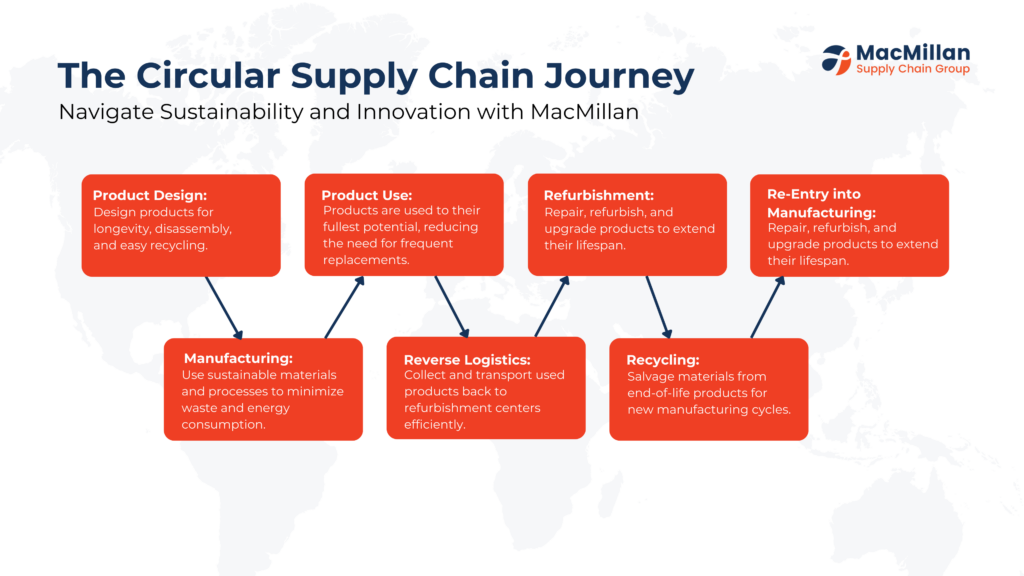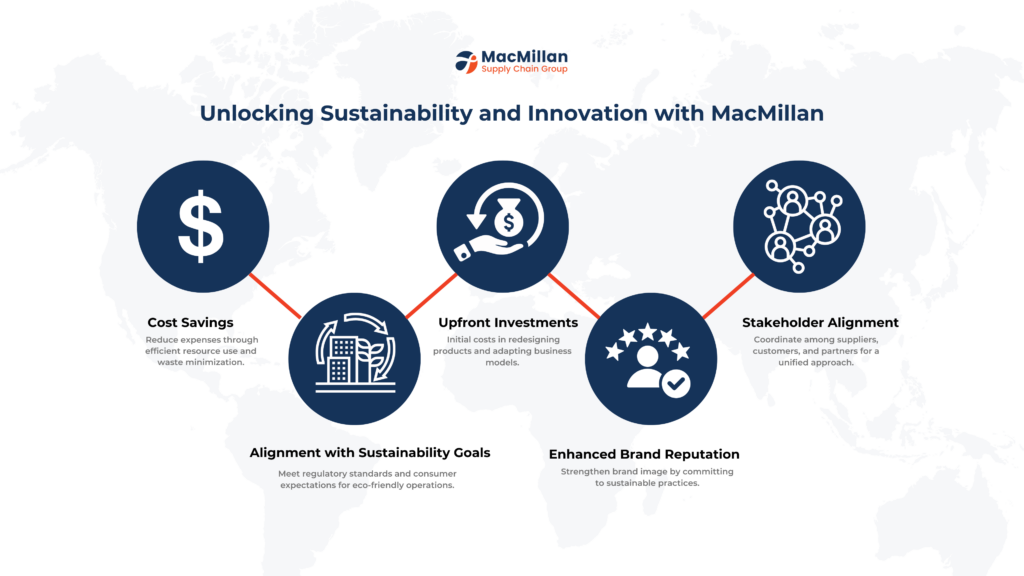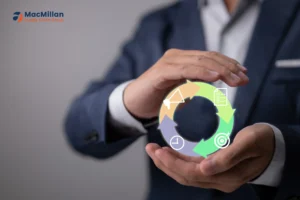A Quick Summary and Overview
Circular supply chains represent a transformative approach to supply chain management, addressing sustainability concerns by maximizing resource utilization and minimizing waste.Businesses can cut costs, spur innovation, and obtain a competitive edge while lessening their environmental impact by rethinking products, putting reverse logistics into practice, and streamlining resource flows.
Overview
Sustainability is no longer just a catchphrase in today’s corporate environment; it is a strategic necessity that is essential to long term success. Businesses are realizing that they need to reconsider their operations as customer preferences and regulatory frameworks move toward eco conscious methods. Presenting the circular supply chain model, a ground breaking idea that offers a route to sustainability, creativity, and profitability while challenging conventional linear approaches. We will examine the complexities of circular supply chains in this extensive guide, including its advantages, elements, difficulties, and methods of implementation.

- What is a Circular Supply Chain?
An alternative to the conventional linear model of “take-make-waste” is a circular supply chain. It is based on the ideas of the circular economy, which emphasizes resource optimization techniques, efficient reverse logistics, and purposeful product design to keep resources in use for as long as possible. Circular supply chains seek to establish a closed loop in which goods and resources are continuously recycled, refurbished, or reused, in contrast to conventional supply chains that prioritize a one-way flow from production to disposal. - Key Components of Circular Supply Chains
Transitioning to a circular supply chain requires a holistic approach that encompasses several key components. Product redesign is a crucial starting point, where products are designed from the outset with longevity, recyclability, and modularity in mind. This not only extends the usable life of products but also facilitates easier disassembly and material recovery.
Reverse logistics systems play a pivotal role in circular supply chains, enabling the collection, inspection, and sorting of used products or components for refurbishment, remanufacturing, or recycling. Effective reverse logistics not only minimizes waste but also creates opportunities for value recovery and new revenue streams.
Another crucial element is resource optimization, which aims to reduce dependency on fresh raw materials and maximize the use of already-existing commodities. Remanufacturing, material recycling, and the use of recycled or renewable inputs in production processes are among methods that can help achieve this. - Advantages of Circular Supply Chain Transition
Businesses can gain a wide range of advantages by adopting circular supply chains, from improved brand recognition and competitive advantages to cost savings and operational improvements. Businesses can achieve significant cost savings in material procurement, waste management, and energy use by avoiding waste and optimizing resource utilization.
Additionally, by pushing companies to reconsider their operational procedures, material selections, and product designs, circular supply chains promote innovation. New goods, services, and company strategies may result from this need for innovation, bringing up new avenues for income generating and market uniqueness.
Circular supply networks help to mitigate environmental deterioration, conserve natural resources, and lower greenhouse gas emissions from a sustainability perspective. Businesses that showcase a dedication to sustainability might obtain a competitive advantage and improve their brand reputation as consumers grow more aware of their environmental impact. - Common Challenges of Circular Supply Chains
While the benefits of circular supply chains are compelling, businesses often face several challenges during the transition process. One of the primary obstacles is the need for upfront investments in product redesign, infrastructure development, and process modifications. This can be particularly challenging for smaller companies with limited resources.
Economic and regulatory barriers can also hinder the adoption of circular supply chains. Lack of financial incentives, limited access to recycling facilities, and inconsistent regulations across regions can create roadblocks and increase operational complexities.
Additionally, aligning diverse stakeholders, such as suppliers, customers, and recyclers, can be a daunting task. Effective collaboration and communication are essential to ensure seamless integration and buy-in across the entire supply chain ecosystem.
Common Problems
Transitioning to a circular supply chain can be a complex and daunting task for many businesses. One common challenge is the need for significant upfront investments in redesigning products, establishing reverse logistics systems, and modifying operational processes. Limited financial resources and expertise can hinder progress, especially for smaller companies.
Navigating the complicated web of regulatory and economic environments is another challenge. The effective application of circular supply chain strategies may be restricted by a lack of funding, poor recycling infrastructure, and varying regional rules.
Additionally, companies frequently have trouble getting a variety of stakeholders including suppliers, consumers, and recyclers to adopt the circular economy philosophy. Conflicting priorities, resistance to change, and a lack of cooperation can all hinder development and reduce the impact of circular supply chain projects.

Macmillan Solutions
At MacMillan Supply Chain, we understand the challenges businesses face when transitioning to circular supply chains. That’s why we offer comprehensive solutions tailored to your specific needs and requirements.
From redesigning products to setting up reliable reverse logistics systems, our team of professionals offers strategic consulting services to help you every step of the way. We use state of the art technology, like data analytics and Internet of Things solutions, to track material movements, optimize resource flows, and find opportunities for value recovery and waste reduction.
Moreover, we collaborate with industry partners, policymakers, and regulatory bodies to advocate for supportive policies and financial incentives that facilitate the adoption of circular supply chain practices. Our extensive network and industry expertise enable us to navigate complex regulatory landscapes and ensure compliance with evolving sustainability standards.
Through strategic partnerships and collaborations, we help you align stakeholders across the supply chain ecosystem, fostering a shared commitment to sustainability and circularity. Our tailored solutions empower businesses to overcome economic barriers, optimize resource utilization, and unlock new revenue streams through innovative business models and value-added services.
How Can Readers Prevent Issues or Put Solutions in Place?
Working with the proper professionals can make all the difference during the road to a circular supply chain. We at MacMillan Supply Chain are aware of the difficulties and complexity involved, and our all-inclusive solutions are made to make this shift as easy as possible for you.
Start by thoroughly evaluating your present supply chain procedures to find areas that could want improvement and possible circularity opportunities. Work with our team of professionals to create a personalized plan that complements your sustainability and commercial objectives.
Leverage our strategic consulting services to redesign products for longevity, recyclability, and resource optimization. Our advanced technologies and data-driven insights will help you establish efficient reverse logistics systems and optimize resource flows, minimizing waste and maximizing value recovery.
Do not let economic barriers or regulatory issues hinder your progress. Our advocacy efforts and industry partnerships ensure you have access to the latest financial incentives, supportive policies, and cutting-edge infrastructure to support your circular supply chain initiatives.
By partnering with MacMillan Supply Chain, you’ll not only unlock the benefits of sustainability and cost savings but also gain a competitive edge through innovation and enhanced brand reputation. Take the first step today by contacting our team and embark on your journey towards a truly circular and sustainable supply chain.
FAQS
A circular supply chain is a sustainable model that focuses on maximizing resource utilization by keeping materials and products in use for as long as possible through various strategies such as reuse, refurbishment, and recycling. It aims to create a closed loop system, minimizing waste and reducing the reliance on virgin raw materials.
Transitioning to a circular supply chain offers numerous benefits, including cost savings through reduced material and energy consumption, opportunities for innovation and new revenue streams, enhanced brand reputation and competitive advantages, and alignment with sustainability goals and regulatory frameworks.
The key components of a circular supply chain include product redesign for longevity and recyclability, effective reverse logistics systems for product collection and material recovery, and resource optimization strategies such as remanufacturing, recycling, and the use of renewable or recycled inputs.
Common challenges include the need for upfront investments in product redesign and infrastructure development, navigating economic and regulatory barriers, aligning diverse stakeholders across the supply chain ecosystem, and overcoming resistance to change.




